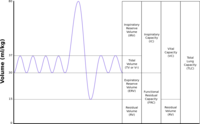
Photo from wikipedia
Forced spirometry is a fundamental procedure in the study of lung function that is essential in the evaluation and follow-up of respiratory diseases. Clinical guidelines published by respiratory societies1–3 require… Click to show full abstract
Forced spirometry is a fundamental procedure in the study of lung function that is essential in the evaluation and follow-up of respiratory diseases. Clinical guidelines published by respiratory societies1–3 require this test to be performed by highly trained technicians. The guidelines of the Spanish Society of Pulmonology and Thoracic Surgery (SEPAR)1 recommend that technicians receive structured training and at least 3 months’ dedicated experience under the supervision of expert technicians, to ensure that they are minimally competent in the procedure. The SEPAR guidelines also state that up to 1 year of experience is necessary to become familiar with the equipment and to develop problem-solving skills. In 2012, the European Respiratory Society initiated a training program, the “European Spirometry Driving License”,4 to offer high-quality comprehensive training to practitioners. The widespread use of spirometry in both primary care and specialized clinics has made quality control increasingly complex.5 The quality of spirometries performed in primary care has always been questioned, due to the difficulty in achieving acceptable, interpretable results. In Navarre, Hueto et al.6 found that adherence to guidelines is very limited, and the quality of 76% of the tests was unacceptable. Naberan et al.7 also reported lack of adherence to guidelines, limited availability of the technique in primary care centers, and shortcomings in training. The situation is compounded by the high demand for spirometry technicians, which puts a severe strain on training resources. This situation inevitably generates significant diagnostic problems, since spirometry is the principal test for evaluating major chronic respiratory diseases, such as asthma and chronic obstructive pulmonary disease. Hueto et al.6 reported that 39.7% of diagnoses were not supported by lung function data. Thus, if an acceptable spirometry is not available, the primary care doctor may have difficulty in managing the diagnosis, treatment, and follow-up of respiratory diseases.
Journal Title: Archivos de bronconeumologia
Year Published: 2018
Link to full text (if available)
Share on Social Media: Sign Up to like & get
recommendations!